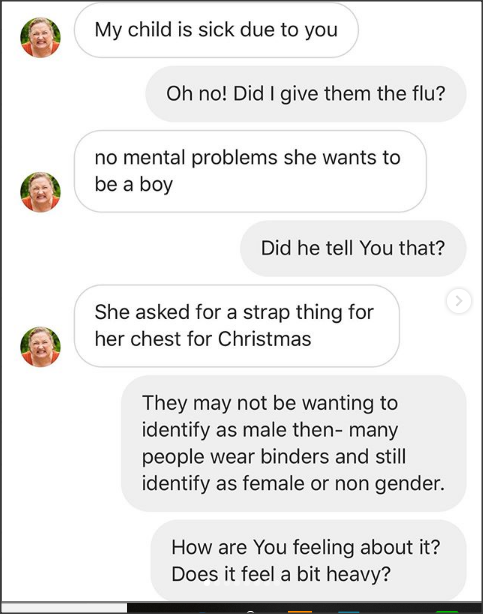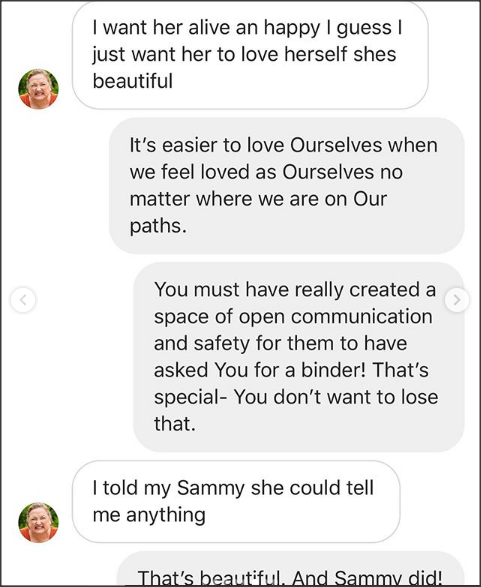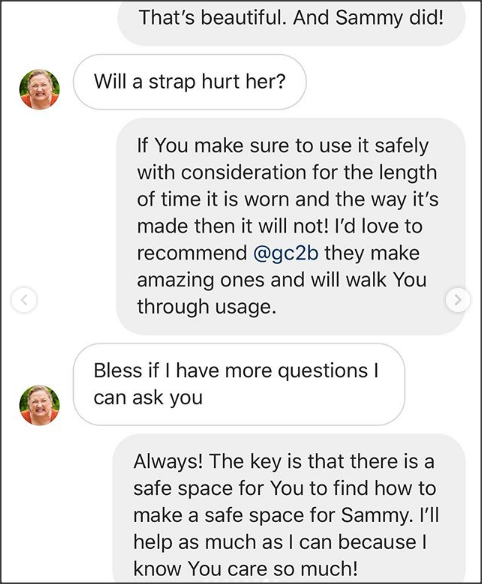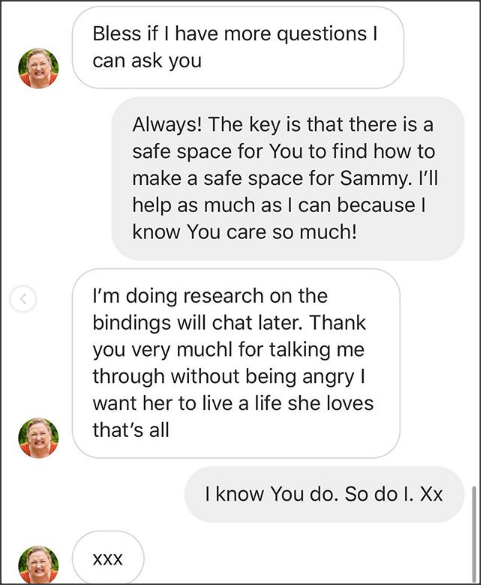Your personal Tumblr library awaits
Communication - Blog Posts
This is phenomenal modeling of taking a confrontation and reshaping it into a constructive dialogue. I'd never heard of the VERA model before, and it's awesome that people have actually articulated the elements of this skill!








Wow. The patience, kindness and calm communication skills. Outstanding.
From raindovemodel
if I don't answer you, check your inbox. I am unable to respond in the chat or comment. The ask and posting on this blog are my only way to communicate with the outside world.
I got good at leaving; but I'm asking you to stay.
These words have been with me for so long they aren't easy to say.
I'm afraid if I speak them to the empty air there won't be anything left of me.
I haven't tried before; I just watched them leave.
So I'm hoping this time, if I give these words to you.
You'll take their place in my chest and say you love me too.
Hi, I'm sorry if you aren't the best person to ask but i cant find anyone else but is it ablest of me to avoid verbally communicating even if I have the ability?
Like I can talk, and it's not particularly hard for me usually, but I feel more comfortable not doing it usually, especially during the times it does hurt. I'm autistic but I don't know if that's the reason why, and I worry it's inconsiderate to not do it by choice since some people don't have one.
Sorry again
It isn't ableist. I've said it before and I will say it again, everyone deserves a comfortable way to communicate. And for you, if using a way other than oral speech is more comfortable, do that!
You deserve to be comfortable, and if that means using AAC, sign, etc. to communicate even though you are speaking. Do it. Somebody who reblogged one of my posts said this, and I think it applies:
"Its called an aid for a reason. You don't NEED a jacket, but winter will be a lot easier if you have one.".
Also, the more people who use AAC the more normalized and available it'll become!
Week 2: Communication




A headcanon of mine is that, due to his isolation, Knuckles has a hard time socializing and probably a fear of public speaking
“Communication” is such an interesting prompt and I love the possibilities!
@year-of-the-echidna
listen to your own inner voice and set boundaries!! your mental and emotional well-being need to be protected!! when you compromise your own values and goals to accommodate the needs and expectations of others, you are sacrificing your own needs and happiness. even if it means disappointing others or standing up against criticism, being assertive and prioritizing your own needs matters! a lot!
One of the worst innovations in communication technology is the "read" status feature on messengers. It intensifies the already unhealthy and unreasonable expectation of constant availability that smartphones have created by putting pressure on recipients to respond immediately to messages and instilling hurt feelings or paranoia in senders. It makes it that much easier for controlling or smothering behavior between family members, lovers or even friends. If any technology fosters an erosion of personal boundaries and personal time, it's this absurd feature. Just turn it off.
Samaa logo design
سماء سرور الشريف، اعلامية و كاتبة عربية من المملكة العربية السعودية تحتاج الى شعار شخصي لاستعماله كتوقيع لها في مدونتها الشخصية.
Samaa Sroor Alsharif, an Arabic media woman and writer from Saudi Arabia, needs a personal logo to be used as her icon on her personal blog.
The following proposal design was chosen as the final logo for the costumer.
View On WordPress
Get over your jealousy and insecurities, there’s a wonderful world of experiences waiting for you both just beyond.
First you must both be secure in yourself and in your relationship.
Never hide anything, just be honest and take it slow.

~D~ it’s as if we wrote this! Distance will never affect your relationship as long as you have these as your foundation!

🐘 Very true words. I think that goes even more in a long distance relationship. 🐘
Tell me your thoughts

People who engage in consensual non-monogamy generally exhibit less jealousy than monogamous couples, because they actively communicate and work through any negative feelings that may arise. Trust is key in any relationship, but especially in non-monogamous ones.
Don’t chicken out! She’s dirtier than you think, she’s just afraid to admit it!

Encourage each other to open up in the privacy of your own bedroom. You’ll likely realize you share fantasies that you both thought were too taboo. Now you can make some of them happen.

Stacy has always been and will always be the center of my world. The rest of you are icing on the cake

Never without permission,
never without each other

We may push boundaries but we have impenetrable boundaries.

A strong relationship is crucial to success in any variety of the lifestyle. Put yourselves first above all else.
Before you test limits, make sure that your relationship is strong and that you always always put your partner first! Discuss and agree upon limits, NEVER cross boundaries!

A strong relationship is crucial to success in any variety of the lifestyle. Put yourselves first above all else.
All-Star Moments in Space Communications and Navigation
How do we get information from missions exploring the cosmos back to humans on Earth? Our space communications and navigation networks – the Near Space Network and the Deep Space Network – bring back science and exploration data daily.
Here are a few of our favorite moments from 2024.

1. Hip-Hop to Deep Space
The stars above and on Earth aligned as lyrics from the song “The Rain (Supa Dupa Fly)” by hip-hop artist Missy Elliott were beamed to Venus via NASA’s Deep Space Network. Using a 34-meter (112-foot) wide Deep Space Station 13 (DSS-13) radio dish antenna, located at the network’s Goldstone Deep Space Communications Complex in California, the song was sent at 10:05 a.m. PDT on Friday, July 12 and traveled about 158 million miles from Earth to Venus — the artist’s favorite planet. Coincidentally, the DSS-13 that sent the transmission is also nicknamed Venus!

NASA's PACE mission transmitting data to Earth through NASA's Near Space Network.
2. Lemme Upgrade You
Our Near Space Network, which supports communications for space-based missions within 1.2 million miles of Earth, is constantly enhancing its capabilities to support science and exploration missions. Last year, the network implemented DTN (Delay/Disruption Tolerant Networking), which provides robust protection of data traveling from extreme distances. NASA’s PACE (Plankton, Aerosol, Cloud, ocean Ecosystem) mission is the first operational science mission to leverage the network’s DTN capabilities. Since PACE’s launch, over 17 million bundles of data have been transmitted by the satellite and received by the network’s ground station.

A collage of the pet photos sent over laser links from Earth to LCRD and finally to ILLUMA-T (Integrated LCRD Low Earth Orbit User Modem and Amplifier Terminal) on the International Space Station. Animals submitted include cats, dogs, birds, chickens, cows, snakes, and pigs.
3. Who Doesn’t Love Pets?
Last year, we transmitted hundreds of pet photos and videos to the International Space Station, showcasing how laser communications can send more data at once than traditional methods. Imagery of cherished pets gathered from NASA astronauts and agency employees flowed from the mission ops center to the optical ground stations and then to the in-space Laser Communications Relay Demonstration (LCRD), which relayed the signal to a payload on the space station. This activity demonstrated how laser communications and high-rate DTN can benefit human spaceflight missions.

4K video footage was routed from the PC-12 aircraft to an optical ground station in Cleveland. From there, it was sent over an Earth-based network to NASA’s White Sands Test Facility in Las Cruces, New Mexico. The signals were then sent to NASA’s Laser Communications Relay Demonstration spacecraft and relayed to the ILLUMA-T payload on the International Space Station.
4. Now Streaming
A team of engineers transmitted 4K video footage from an aircraft to the International Space Station and back using laser communication signals. Historically, we have relied on radio waves to send information to and from space. Laser communications use infrared light to transmit 10 to 100 times more data than radio frequency systems. The flight tests were part of an agency initiative to stream high-bandwidth video and other data from deep space, enabling future human missions beyond low-Earth orbit.

The Near Space Network provides missions within 1.2 million miles of Earth with communications and navigation services.
5. New Year, New Relationships
At the very end of 2024, the Near Space Network announced multiple contract awards to enhance the network’s services portfolio. The network, which uses a blend of government and commercial assets to get data to and from spacecraft, will be able to support more missions observing our Earth and exploring the cosmos. These commercial assets, alongside the existing network, will also play a critical role in our Artemis campaign, which calls for long-term exploration of the Moon.

On Monday, Oct. 14, 2024, at 12:06 p.m. EDT, a SpaceX Falcon Heavy rocket carrying NASA’s Europa Clipper spacecraft lifts off from Launch Complex 39A at NASA’s Kennedy Space Center in Florida.
6. 3, 2, 1, Blast Off!
Together, the Near Space Network and the Deep Space Network supported the launch of Europa Clipper. The Near Space Network provided communications and navigation services to SpaceX’s Falcon Heavy rocket, which launched this Jupiter-bound mission into space! After vehicle separation, the Deep Space Network acquired Europa Clipper’s signal and began full mission support. This is another example of how these networks work together seamlessly to ensure critical mission success.

Engineer Adam Gannon works on the development of Cognitive Engine-1 in the Cognitive Communications Lab at NASA’s Glenn Research Center.
7. Make Way for Next-Gen Tech
Our Technology Education Satellite program organizes collaborative missions that pair university students with researchers to evaluate how new technologies work on small satellites, also known as CubeSats. In 2024, cognitive communications technology, designed to enable autonomous space communications systems, was successfully tested in space on the Technology Educational Satellite 11 mission. Autonomous systems use technology reactive to their environment to implement updates during a spaceflight mission without needing human interaction post-launch.

A first: All six radio frequency antennas at the Madrid Deep Space Communication Complex, part of NASA’s Deep Space Network (DSN), carried out a test to receive data from the agency’s Voyager 1 spacecraft at the same time.
8. Six Are Better Than One
On April 20, 2024, all six radio frequency antennas at the Madrid Deep Space Communication Complex, part of our Deep Space Network, carried out a test to receive data from the agency’s Voyager 1 spacecraft at the same time. Combining the antennas’ receiving power, or arraying, lets the network collect the very faint signals from faraway spacecraft.
Here’s to another year connecting Earth and space.
Make sure to follow us on Tumblr for your regular dose of space!

9 Out-of-This-World Moments for Space Communications & Navigation in 2023
How do astronauts and spacecraft communicate with Earth?
By using relay satellites and giant antennas around the globe! These tools are crucial to NASA’s space communications networks: the Near Space Network and the Deep Space Network, which bring back science and exploration data every day.
It’s been a great year for our space communications and navigation community, who work to maintain the networks and enhance NASA’s capabilities. Keep scrolling to learn more about our top nine moments.

The SpaceX Falcon 9 rocket carrying the Dragon spacecraft lifts off from Launch Complex 39A at NASA's Kennedy Space Center in Florida on Thursday, Nov. 9, 2023, on the company's 29th commercial resupply services mission for the agency to the International Space Station. Liftoff was at 8:28 p.m. EST.
1. In November, we launched a laser communications payload, known as ILLUMA-T, to the International Space Station. Now, ILLUMA-T and the Laser Communications Relay Demonstration (LCRD) are exchanging data and officially complete NASA’s first two-way, end-to-end laser relay system. Laser communications can send more data at once than traditional radio wave systems – think upgrading from dial-up to fiber optic internet. ILLUMA-T and LCRD are chatting at 1.2 gigabits per second (Gbps). At that rate, you could download an average movie in under a minute.

NASA’s InSight lander captured this selfie on Mars on April 24, 2022, the 1,211th Martian day, or sol, of the mission.
2. Data analyzed in 2023 from NASA’s retired InSight Mars lander provided new details about how fast the Red Planet rotates and how much it wobbles. Scientists leveraged InSight’s advanced radio technology, upgrades to the Deep Space Network, and radio signals to determine that Mars’ spin rate is increasing, while making the most precise measurements ever of Mars’ rotation.

TBIRD is demonstrating a direct-to-Earth laser communications link from low Earth orbit to a ground station on Earth.
3. We set a new high record! The TeraByte InfraRed Delivery (TBIRD) payload – also demonstrating laser communications like ILLUMA-T and LCRD – downlinked 4.8 terabytes of data at 200 Gbps in a single 5-minute pass. This is the highest data rate ever achieved by laser communications technology. To put it in perspective a single terabyte is the equivalent of about 500 hours of high-definition video.

A 34-meter (112-foot) wide antenna at Canberra Deep Space Communications Complex near Canberra, Australia.
4. This year we celebrated the Deep Space Network’s 60th anniversary. This international array of antennas located at three complexes in California, Spain, and Australia allow us to communicate with spacecraft at the Moon and beyond. Learn more about the Deep Space Network’s legacy and future advancements.

An illustration of the LunaNet architecture. LunaNet will bring internet-like services to the Moon.
5. We are bringing humans to the Moon with Artemis missions. During expeditions, astronauts exploring the surface are going to need internet-like capabilities to talk to mission control, understand their routes, and ensure overall safety. The space comm and nav group is working with international partners and commercial companies to develop LunaNet, and in 2023, the team released Draft LunaNet Specification Version 5, furthering development.

The High-Rate Delay Tolerant Networking node launched to the International Space Station in November and will act as a high-speed path for data.
6. In addition to laser communications, ILLUMA-T on the International Space Station is also demonstrating high-rate delay/disruption tolerant networking (HDTN). The networking node is showcasing a high-speed data path and a store-and-forward technique. HDTN ensures data reaches its final destination and isn’t lost on its path due to a disruption or delay, which are frequent in the space environment.

The Communications Services Project (CSP) partners with commercial industry to provide networking options for future spaceflight missions.
7. The space comm and nav team is embracing the growing aerospace industry by partnering with commercial companies to provide multiple networking options for science and exploration missions. Throughout 2023, our commercialization groups engaged with over 110 companies through events, one-on-one meetings, forums, conferences, and more. Over the next decade, NASA plans to transition near-Earth services from government assets to commercial infrastructure.

Middle and high school students solve a coding experiment during NASA's Office of STEM Engagement App Development Challenge.
8. Every year, NASA’s Office of STEM Engagement sponsors the App Development Challenge, wherein middle and high school students must solve a coding challenge. This year, student groups coded an application to visualize the Moon’s South Pole region and display information for navigating the Moon’s surface. Our space communications and navigation experts judged and interviewed students about their projects and the top teams visited NASA’s Johnson Space Center in Houston!

A SpaceX Falcon 9 rocket soars upward after liftoff at the pad at 3:27 a.m. EDT on Saturday, Aug. 26, from Kennedy Space Center’s Launch Complex 39A in Florida carrying NASA’s SpaceX Crew-7 crew members to the International Space Station. Aboard SpaceX’s Dragon spacecraft are NASA astronaut Jasmin Moghbeli, ESA (European Space Agency) astronaut Andreas Mogensen, JAXA (Japan Aerospace Exploration Agency) astronaut Satoshi Furukawa, and Roscosmos cosmonaut Konstantin Borisov.
9. The Near Space Network supported 19 launches in 2023! Launches included Commercial Crew flights to the International Space Station, science mission launches like XRISM and the SuperBIT balloon, and many more. Once in orbit, these satellites use Near Space Network antennas and relays to send their critical data to Earth. In 2023, the Near Space Network provided over 10 million minutes of communications support to missions in space.
Here’s to another year connecting Earth and space.
Make sure to follow us on Tumblr for your regular dose of space!
Lasers Bring Internet Speeds to Space
Pew. Pew. Lasers in space!
Iconic movie franchises like Star Wars and Star Trek feature futuristic laser technologies, but space lasers aren’t limited to the realm of science fiction. In fact, laser communications technologies are changing the way missions transmit their data. The Laser Communications Relay Demonstration (LCRD) blasts into space this weekend, demonstrating the unique – and totally awesome – capabilities of laser communications systems.

Currently, NASA missions rely on radio frequency to send data to Earth. While radio has served the agency well since the earliest days of spaceflight, there are significant benefits to laser systems. Just as the internet has gone from dial-up to high-speed connections, lasers communications’ higher frequency allows missions to send much more information per second than radio systems. With laser communications, it would only take nine days to transmit a complete map of Mars back to Earth, compared to nine weeks with radio frequency systems.

LCRD will demonstrate these enhanced capabilities from 22,000 miles above Earth’s surface. And although the mission uses lasers, these lasers are not visible to the human eye. Once in orbit, the mission will perform experiments using two telescopes on Earth that will relay data through the spacecraft from one site to the other over an optical communications link. These experiments will help NASA and the aerospace community understand the operational challenges of using lasers to communicate to and from space.

On Earth, there are ground stations telescopes that will capture LCRD’s laser signal and send the data to the mission operations center in New Mexico. The two ground stations are located on Haleakalā, Hawaii and Table Mountain, California. These picturesque locations weren’t chosen because they’re beautiful, but rather for their mostly clear skies. Clouds – and other atmospheric disturbances – can disrupt laser signals. However, when those locations do get cloudy, we’ve developed corrective technologies to ensure we receive and successfully decode signals from LCRD.

This demonstration will help NASA, researchers, and space companies learn more about potential future applications for laser communications technologies. In the next few years, NASA will launch additional laser missions to the Moon on Artemis II and to the asteroid belt, even deeper into space. These missions will give us insight on the use of laser communications further in space than ever before.

Ultimately, laser systems will allow us to glean more information from space. This means more galaxy pics, videos of deep space phenomena, and live, 4K videos from astronauts living and working in space.
Laser communications = more data in less time = more discoveries.
If laser communications interests you, check out our Space Communications and Navigation (SCaN) Internship Project. This program provides high school, undergrad, graduate, and even Ph.D. candidates with internship opportunities in space communications areas – like laser comm.
Make sure to follow us on Tumblr for your regular dose of space!
Launching the Future of Space Communications
Our newest communications satellite, named the Tracking and Data Relay Satellite-M or TDRS-M, launches Aug. 18 aboard an Atlas V rocket from our Kennedy Space Center in Florida. It will be the 13th TDRS satellite and will replenish the fleet of satellites supporting the Space Network, which provides nearly continuous global communications services to more than 40 of our missions.

Communicating from space wasn’t always so easy. During our third attempt to land on the moon in 1970, the Apollo 13 crew had to abort their mission when the spacecraft’s oxygen tank suddenly exploded and destroyed much of the essential equipment onboard. Made famous in the movie ‘Apollo 13’ by Ron Howard and starring Tom Hanks, our NASA engineers on the ground talked to the crew and fixed the issue. Back in 1970 our ground crew could only communicate with their ground teams for 15 percent of their orbit – adding yet another challenge to the crew. Thankfully, our Apollo 13 astronauts survived and safely returned to Earth.

Now, our astronauts don’t have to worry about being disconnected from their teams! With the creation of the TDRS program in 1973, space communications coverage increased rapidly from 15 percent coverage to 85 percent coverage. And as we’ve continued to add TDRS spacecraft, coverage zoomed to over 98 percent!

TDRS is a fleet of satellites that beam data from low-Earth-orbiting space missions to scientists on the ground. These data range from cool galaxy images from the Hubble Space Telescope to high-def videos from astronauts on the International Space Station! TDRS is operated by our Space Network, and it is thanks to these hardworking engineers and scientists that we can continuously advance our knowledge about the universe!

What’s up next in space comm? Only the coolest stuff ever! LASER BEAMS. Our scientists are creating ways to communicate space data from missions through lasers, which have the ability to transfer more data per minute than typical radio-frequency systems. Both radio-frequency and laser comm systems send data at the speed of light, but with laser comm’s ability to send more data at a time through infrared waves, we can receive more information and further our knowledge of space.

How are we initiating laser comm? Our Laser Communications Relay Demonstration is launching in 2019! We’re only two short years away from beaming space data through lasers! This laser communications demo is the next step to strengthen this technology, which uses less power and takes up less space on a spacecraft, leaving more power and room for science instruments.

Watch the TDRS launch live online at 8:03 a.m. EDT on Aug. 18: https://www.nasa.gov/nasalive
Join the conversation on Twitter: @NASA_TDRS and @NASALasercomm!
Make sure to follow us on Tumblr for your regular dose of space: http://nasa.tumblr.com
Top 10 Ways the Space Station is Helping Get Us to Mars
Believe it or not, the International Space Station is paving our way to Mars. Being the only microgravity laboratory in which long-duration investigations can take place, it provides deeper understanding of how the human body reacts to long-term spaceflight. Here are the top 10 ways the space station is helping us on our journey to the Red Planet:
10: Communication Delays

Have you ever sent a text and got frustrated when it took longer than 3 seconds to send? Imaging communicating from Mars where round-trip delays could take up to 31 minutes! Our Comm Delay Assessment studies the effects of delayed communications for interplanetary crews that have to handle medical and other emergencies in deep space.
9. Astronaut Functional Performance

After a long nights sleep, do you ever feel a bit clumsy when you first get out of bed? Imagine how crew members might feel after spending six months to a year in microgravity! Our Field Test investigation is working to understand the extend of physical changes in astronauts who live in space for long periods of time, with an aim toward improving recovery time and developing injury prevention methods for future missions.
8. Psychological Impacts of Isolation and Confinement

In order to study the behavioral issues associated with isolation and confinement, researchers evaluate the personal journals of space station crew members. These study results provide information to help prepare us for longer duration spaceflight.
7. Impacts on Vision

Did you know that long duration spaceflight can often cause changes to crew members’ vision? It can, and our Ocular Health study monitors microgravity-induced visual impairment, as well as changes believed to arise from elevated intracranial pressure. All of this work hopes to characterize how living in microgravity can affect the visual, vascular and central nervous systems.
6. Immune Responses

An important aspect of our journey to Mars is the need to understand how long-duration spaceflight affects they way crew members’ bodies defend agains pathogens. Our Integrated Immune investigation collects and analyzes blood, urine and saliva samples from crew members before, during and after spaceflight to monitor changes in the immune system.
5. Food for Long-Duration Crews

Just like a hiker preparing for a long trek, packing the foods that will give you the most energy for the longest amount of time is key to your success. This is also true for astronauts on long-duration missions. Our Energy investigation measures a crew members’ energy requirements, which is a crucial factor needed for sending the correct amount of the right types of food to space.
4. Exercise for Long-Term Missions

Rigorous exercise is already a regular part of astronauts’ routines, and continuing that focus will be critical to keeping crew members’ bodies strong and ready for a mission to Mars and a healthy return to Earth. Our Sprint investigation is studying the best combination of intensity and duration for exercise in space.
3. Determine Best Habitat/Environment for Crews

Have you ever complained about your room being too small? Imagine living in cramped quarters with an entire crew for months on a Mars mission! Our Habitability investigation collects observations that will help spacecraft designers understand how much habitable volume is required, and whether a mission’s duration impacts how much space crew members need.
2. Growing Food in Space

There’s nothing like fresh food. Not only does it provide valuable nutrition for astronauts, but can also offer psychological benefits from tending and harvesting the crops. Our Veggie investigation studies how to best utilize a facility aboard the space station for growing fresh produce in microgravity.
1. Manufacturing Items in Space

When crews head to Mars, there may be items that are unanticipated or that break during the mission. Our 3-D Printing in Zero-G Technology Demonstration would give crews the ability to manufacture new objects on demand while in space.
Make sure to follow us on Tumblr for your regular dose of space:http://nasa.tumblr.com
It wasn't a coincidence…

“Let us make a special effort to stop communicating with each other, so we can have some conversation.” - Mark Twain
Illustration by Juan Carlos Paz
Turning conventional restrooms into coed bathrooms is not a sin against the Christian God. And, assuming that there will be men who just say they identify as women merely to get inside a woman's bathroom is ridiculous, and that devalues the experience of those who actually identify unconventionally.
Maybe instead of putting so much emphasis on only two genders, male and female, we instead reinterpret our core beliefs to embrace masculine and feminine energy, and souls, as opposed to male and female bodies.
Maybe it's time to address why traditional Christians are so overly obsessed with sex and gender and purity. As well as why traditional Christians are overly obsessed with sin, and do not give notice to the essence of connection and love that can bring humanity together for the greater good as a whole as opposed to an "us vs them" mentality of the "haves and have nots," the straight and the unconventional; the dualism that has oversaturated the minds of traditional Christians to the point that they can't even accept that there has always been more than two genders, Middlesex people and eunuchs, and other outcasts that have been in our societies as long as humans have been around.
Maybe we ask ourselves why we believe what we believe, why are we not open to expanding our beliefs outside of the traditional walls we've been raised in? Why is it so hard for us to understand that people are people, and it's been those who are judgmental that have excluded outcasts such as LGBTQ+ & gender non-conforming people. Is being a beloved child of God an exclusive opportunity reserved only for those who are perfect in Christ? Newsflash, no human is perfect, we all have cast stones at others to move the spotlight off of our own missed marks and insecurities. We project all over each other all the time.
If you're a traditional Christian, I challenge you to challenge your beliefs. Ask yourself why you believe what you do, without referencing something you've been told or heard someone else say. When that happens and you can legitimately defend your stances on traditional Christianity, I'd love to have a conversation about hot topics such as trans rights, LGBTQ+ rights, equity and equality of BIPOC and Native Americans, and all marginalized groups. I'd like to talk about socialism versus capitalism and the influence of religion on our politics. We need to be having conversations with people we do not agree with, and not only that, we all need to be open to learning something uncomfortable, challenging to our own beliefs, and have the ability to open our minds to other cultures and ways of life. Just a thought
I have swallowed molten lead. Swallowed it myself. It tasted like empty seats in crammed up rooms and a pile of gathering dread.
It tastes like whispers I can't hear, my mouthful of molten lead. Like train tickets, bus fares I've never seen, and farewells that remain unsaid.
It tastes like rhythms I can't balance, my stomach of molten lead. Like the half rotted sweetness of memories in retrospect, and a pile that is already dead.

Is it really all that important to use a VPN (Virtual Private Network) for most of Your Communications?


